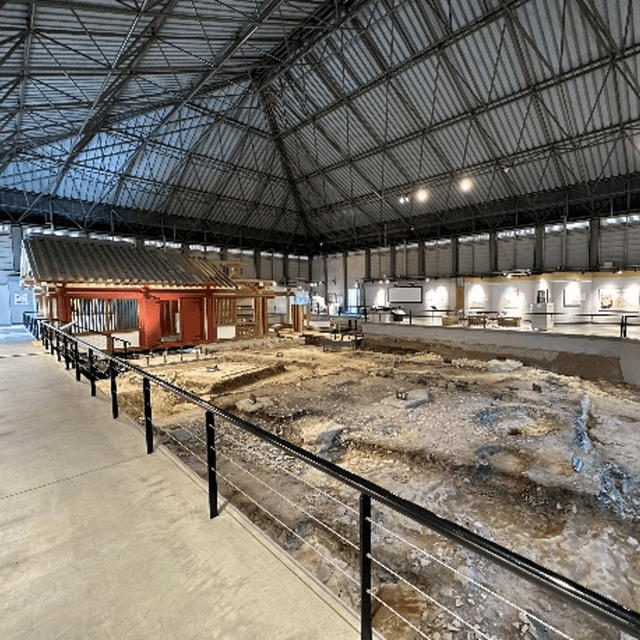
鴻臚館は古代の外交施設で、平安京、難波(なにわ)、筑紫の三ヵ所に設置されたとされています。その名は古代中国で外国との交渉を司る「鴻臚寺」に由来し、「鴻」は大きい、「臚」は伝えるという意味があります。
筑紫の鴻臚館が初めて登場するのは、『日本書紀』の持統(じとう)2(688)年の記事で、当時は筑紫館(つくしのむろつみ/つくしのたち)と呼ばれていました。9世紀前半までは、唐や新羅(しらぎ/しるら)の使節を接待・宿泊させる迎賓館や、遣唐使や遣新羅使が旅支度を整える対外公館として機能していました。9世紀後半以降は、鴻臚館を訪れる主役は唐(後には五代・北宋)の商人となり、中国との貿易の舞台となりました。11世紀後半に貿易拠点が鴻臚館の東の砂丘にある博多に移るまで、古代日本最大の国際交流の拠点として機能しました。
鴻臚館の位置については永らく不明で、博多の呉服町(ごふくまち)とする説が有力でしたが、九州大学元医学部教授の中山平次郎(なかやまへいじろう)博士が『万葉集』、古絵図、地形、出土遺物等の検討から福崎(ふくさき)(福岡城内)説を提唱しました。その後、昭和62(1987)年12月、平和台球場改修工事に伴う発掘調査で、鴻臚館の関連遺構が発見されたことにより、中山博士の説が補強され、現在では福岡城内が定説となっています。
遺構も福岡市による調査が行われており、現在までに奈良時代以前(筑紫館)の塀と門、奈良時代(筑紫館)の塀と掘立柱建物、平安時代の大型礎石建物、土壙(どこう)(穴状の遺構)、溝などが見つかっています。また、多量の瓦類の他、中国越州窯青磁(えっしゅうようせいじ)をはじめ長沙窯磁器(ちょうさようじき)、荊窯白磁(けいようはくじ)、イスラム陶器、西アジアガラス器など国際色豊かな遺物が発掘されています。発掘された遺構や遺物は現在、福岡城内の展示館にて公開されています。発掘当時の様子をそのまま保存した展示は圧巻です。
【開館時間】9:00~17:00(入館は16:30まで)
【休館日】12月29日~1月3日
【入館料】無料
詳細は公式HPをご参照ください。
URL:https://fukuokajyo.com/kourokan/
Korokan was an ancient governmental facility for diplomacy, said to have been established in three locations—Heian-kyō, Naniwa, and Tsukushi. Its name derives from China’s “Honglu Si,” the office in charge of foreign relations in antiquity: “鴻 (kō)” means “great,” and “臚 (ro)” means “to announce.”
The first appearance of the Tsukushi Korokan is in the Nihon Shoki, Japan's oldest historical chronicle, in an entry for 688 (Jitō 2), where it was called the Tsukushikan. Up through the first half of the 9th century it functioned as a state guesthouse that received and lodged envoys from Tang China and Silla (ancient Korean kingdom), and as an external-relations facility where Japan’s missions to Tang and Silla prepared for their journeys. From the latter half of the 9th century onward, merchants from Tang (and later from the Five Dynasties and Northern Song) became the principal visitors, and the site served as a stage for trade with China. Until the latter half of the 11th century—when the trading center shifted east to Hakata, on the dunes east of the Korokan—it functioned as ancient Japan’s largest hub of international exchange.
The location of the Korokan long remained unknown, with a leading theory placing it in Hakata’s Gofukumachi district. Professor Nakayama Heijirō, formerly of Kyushu University’s Faculty of Medicine, advanced the “Fukusaki (within Fukuoka Castle)” theory based on evidence from the Man’yōshū (a collection of classical poetry), old maps, topography, and excavated artifacts. In December 1987, remains related to the Korokan were discovered during excavations conducted for renovations to Heiwadai Stadium, corroborating Nakayama’s theory; today the consensus is that it stood within Fukuoka Castle.
Surveys by the City of Fukuoka have identified, to date: fences and a gate from before the Nara period (for the Tsukushikan); Nara-period fences and post-built structures; and, from the Heian period, large buildings on foundation stones, pit features, and ditches. In addition to large quantities of roof tiles, an internationally diverse array of artifacts has been unearthed, including Yue-ware celadon ceramics from China, Changsha-kiln ceramics, Jing-kiln white ware, Islamic pottery, and Western Asian glass vessels. The excavated structures and artifacts are now on public display at a museum within the Fukuoka Castle grounds, with a riveting presentation that preserves the appearance of the site at the time of excavation.
Opening hours: 9:00 a.m. to 5:00 p.m. (last entry: 4:30 p.m.)
Closed: December 29–January 3
Admission: Free
For details, please see the official website: https://fukuokajyo.com/kourokan/
スタンプを獲得すると、限定の壁紙をゲットできます。
スタンプを集めてね / Collect a stamp
限定の壁紙を獲得しました。
以下のボタンから壁紙を表示し、長押しで”写真”に保存してください。
